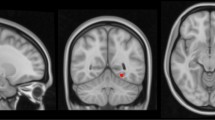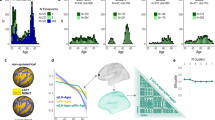Abstract
Cortical thinning is a part of normal ageing. Recent studies suggest that accelerated cortical thinning in vulnerable regions may be a useful biomarker for neuropathologies including Alzheimer’s disease (AD). Longitudinal studies, which have largely focused on older adults, have provided estimates of normative rates and patterns of age-related cortical thinning. Very little, however, is known about healthy cortical thinning at midlife. Here we provide longitudinal estimates of age-related cortical thinning observed over 8 years, in a large (n = 404) group of healthy individuals aged 44–49 years at baseline, who were scanned with MRI (1.5T) on up to three occasions. Age-related cortical thinning was assessed across the whole cortex. We measured a mean annual decrease in cortical thickness of 0.26 % on the left and 0.17 % on the right hemisphere, and largely affecting frontal and cingulate cortices. Medial and lateral temporal regions were generally spared. Studying regions that are specifically vulnerable to—or spared from—healthy age-related cortical thinning at midlife may be important for the early identification of neurodegeneration, including AD.



Similar content being viewed by others
References
Andrews-Hanna JR, Snyder AZ, Vincent JL, Lustig C, Head D, Raichle ME, Buckner RL (2007) Disruption of large-scale brain systems in advanced aging. Neuron 56:924–935
Anstey KJ et al (2012) Cohort profile: the PATH through life project. Int J Epidemiol 41:951–960
Bernal-Rusiel JL, Greve DN, Reuter M, Fischl B, Sabuncu MR (2013) Statistical analysis of longitudinal neuroimage data with linear mixed effects models. NeuroImage 66:249–260
Driscoll I, Davatzikos C, An Y, Wu X, Shen D, Kraut M, Resnick S (2009) Longitudinal pattern of regional brain volume change differentiates normal aging from MCI. Neurology 72:1906–1913
Fischl B (2012) FreeSurfer. NeuroImage 62:774–781
Fjell AM, Walhovd KB (2010) Structural brain changes in aging: courses, causes and cognitive consequences. Rev Neurosci 21:187–222
Fjell AM, McEvoy L, Holland D, Dale AM, Walhovd KB (2013a) Brain changes in older adults at very low risk for Alzheimer’s disease. J Neurosci 33:8237–8242
Fjell AM et al (2013b) Critical ages in the life course of the adult brain: nonlinear subcortical aging. Neurobiol Aging 34:2239–2247
Fjell AM et al (2014) Accelerating cortical thinning: unique to dementia or universal in aging? Cereb Cortex 24:919–934
Fraser MA, Shaw ME, Cherbuin N (2015) A systematic review and meta-analysis of longitudinal hippocampal atrophy in healthy human ageing. NeuroImage 112:364–374
Gur RC et al (1991) Gender differences in age effect on brain atrophy measured by magnetic resonance imaging. Proc Natl Acad Sci USA 88:2845–2849
Liu Y et al (2012) Education increases reserve against Alzheimer’s disease—evidence from structural MRI analysis. Neuroradiology 54:929–938
Lu T, Pan Y, Kao S-Y, Li C, Kohane I, Chan J, Yankner BA (2004) Gene regulation and DNA damage in the ageing human brain. Nature 429:883–891
McDonald C et al (2009) Regional rates of neocortical atrophy from normal aging to early Alzheimer disease. Neurology 73:457–465
McGinnis SM, Brickhouse M, Pascual B, Dickerson BC (2011) Age-related changes in the thickness of cortical zones in humans. Brain Topogr 24:279–291
Pfefferbaum A, Rohlfing T, Rosenbloom MJ, Chu W, Colrain IM, Sullivan EV (2013) Variation in longitudinal trajectories of regional brain volumes of healthy men and women (ages 10 to 85 years) measured with atlas-based parcellation of MRI. NeuroImage 65:176–193
Raz N (2000) Aging of the brain and its impact on cognitive performance: integration of structural and functional findings. In: Craik FIM, Salthouse TA (eds) The handbook of aging and cognition, 2nd edn. Lawrence Erlbaum Associates Publishers, Mahwah, pp 1–90
Raz N, Rodrigue K, Head D, Kennedy K, Acker J (2004) Differential aging of the medial temporal lobe a study of a five-year change. Neurology 62:433–438
Reuter M, Schmansky NJ, Rosas HD, Fischl B (2012) Within-subject template estimation for unbiased longitudinal image analysis. NeuroImage 61:1402–1418
Salat DH et al (2004) Thinning of the cerebral cortex in aging. Cereb Cortex 14:721–730
Schnack HG et al (2015) Changes in thickness and surface area of the human cortex and their relationship with intelligence. Cereb Cortex 25:1608–1617
Shaw ME, Sachdev PS, Anstey KJ, Cherbuin N (2016) Age-related cortical thinning in cognitively healthy individuals in their 60 s: the PATH through life study. Neurobiol Aging 39:202–209
Sled JG, Zijdenbos AP, Evans AC (1998) A nonparametric method for automatic correction of intensity nonuniformity in MRI data. IEEE Trans Med Imaging 17:87–97
Sowell ER, Peterson BS, Thompson PM, Welcome SE, Henkenius AL, Toga AW (2003) Mapping cortical change across the human life span. Nat Neurosci 6:309–315
Storsve AB, Fjell AM, Tamnes CK, Westlye LT, Overbye K, Aasland HW, Walhovd KB (2014) Differential longitudinal changes in cortical thickness, surface area and volume across the adult life span: regions of accelerating and decelerating change. J Neurosci 34:8488–8498
Strachan MW, Reynolds RM, Marioni RE, Price JF (2011) Cognitive function, dementia and type 2 diabetes mellitus in the elderly. Nat Rev Endocrinol 7:108–114
Thambisetty M, Wan J, Carass A, An Y, Prince JL, Resnick SM (2010) Longitudinal changes in cortical thickness associated with normal aging. NeuroImage 52:1215–1223
Weiner MW et al (2013) The Alzheimer’s disease neuroimaging initiative: a review of papers published since its inception. Alzheimer’s Dement 9:e111–e194
Acknowledgments
The authors are grateful to Peter Butterworth, Simon Easteal, Helen Christensen, Patricia Jacomb, Karen Maxwell, and the PATH interviewers. The study was supported by NHMRC Grant No. 973302, 179805, 350833, 157125, ARC Grant No. 130101705, and the Dementia Collaborative Research Centres and the Canberra Hospital Salaried Doctors Private Practice Trust Fund. Nicolas Cherbuin and Kaarin Anstey are funded by ARC Fellowship No. 12010227 and NHMRC Fellowship No. 1002560. This research was partly undertaken on the National Computational Infrastructure (NCI) facility in Canberra, Australia, which is supported by the Australian Commonwealth Government.
Author information
Authors and Affiliations
Corresponding author
Electronic supplementary material
Below is the link to the electronic supplementary material.
Rights and permissions
About this article
Cite this article
Shaw, M.E., Abhayaratna, W.P., Sachdev, P.S. et al. Cortical Thinning at Midlife: The PATH Through Life Study. Brain Topogr 29, 875–884 (2016). https://doi.org/10.1007/s10548-016-0509-z
Received:
Accepted:
Published:
Issue Date:
DOI: https://doi.org/10.1007/s10548-016-0509-z




